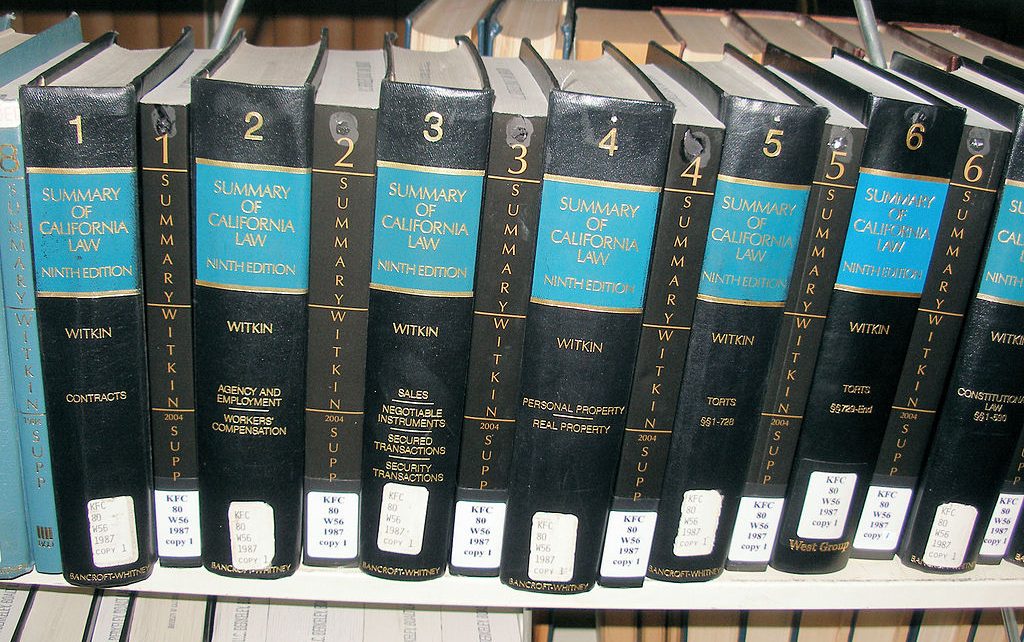
Summary of California Law books. (Photo: Wikipedia)
Using Model or Uniform Acts for Bill Drafting
Depending on the state legislature, uniform laws and model acts can be important starting points for drafting legislation
By Chris Micheli, December 16, 2020 6:13 am
When drafting new laws in California, sometimes interest groups and those drafting legislation may turn to model laws or uniform acts. They also may review similar laws adopted by the federal government or other states. As you might imagine, there are positive and negative aspects of using these other laws when drafting in California.
Although bill drafting requires creativity in many instances, if a statute is working well in another jurisdiction, it may not be necessary to “re-create the wheel.” Similar laws in California, as well as those in other states, might be useful. These uniform and model acts come from a variety of sources.
The Uniform Law Commission (ULC, also known as the National Conference of Commissioners on Uniform State Laws), which was established in 1892, “provides states with non-partisan, well-conceived and well-drafted legislation that brings clarity and stability to critical areas of state statutory law.” The ULC has promulgated more than 300 uniform and model acts on numerous subjects including commerce, family and domestic relations, real estate transactions, trusts and estates, and alternate dispute resolution.
According to the ULC, “a uniform act is one that seeks to establish the same law on a subject among the various jurisdictions. An act is designated as a “Uniform” Act if there is substantial reason to anticipate enactment in a large number of jurisdictions, and uniformity of the provisions of the act among the various jurisdictions is a principal objective.” The UCL is the primary drafter of uniform laws to promote uniformity among the state laws in particular areas.
In addition, the ULC explains, “an act is designated as a “Model” Act if uniformity may be a desirable objective, though not a principal objective, and the act may promote uniformity and minimize diversity even though a significant number of jurisdictions may not adopt the act in its entirety, or the purposes of the act can be substantially achieved even though it is not adopted in its entirety by every state.” Model acts are proposed by a number of organizations, including the American Bar Association (ABA), American Law Institute (ALI), and others.
While uniform and model acts have differences, they share the commonality of carefully drafted model laws that may be enacted by state legislatures across the country. As a result, state legislature can enact them without change, not enact them, or enact them with changes. While uniform laws are intended to be adopted in their entirety, model acts are often used as the starting point for state laws and are usually not adopted in their entirety by state legislatures.
Regardless of whether the bill drafter reviews a model act or a uniform law, using these legislative precedents from other jurisdictions also likely require modification. In other words, you will not want to simply “cut and paste” from another a model or uniform act without taking into account several factors, including:
- Is the act consistent with California’s method of drafting statutes or are modifications required?
- Does the act have any provisions that would be inconsistent with existing California law?
- Does the act contain any ambiguous provisions?
- In jurisdictions that have adopted the act, how have their courts interpreted the act’s provisions?
- How does the act fit with the existing statutory scheme in this state?
- Are terms in the act consistent with how those terms may be defined elsewhere in California law?
- Are the rules for interpreting the act consistent with interpretation guidelines in this state?
Depending on the state legislature, uniform laws and model acts can be important starting points for drafting legislation. Depending on legislators in a particular state, some or all of these acts may be utilized, but it is important to remember that there may be differences that need to be taken into account when using model act language for a particular jurisdiction.
- Enforcement of Judgments in California - December 13, 2025
- General Provisions Related to Family Law Support - December 13, 2025
- Petitions for Forming Harbor Districts in California - December 12, 2025



